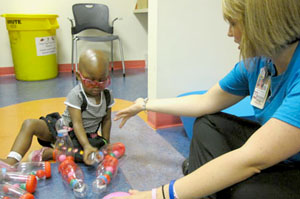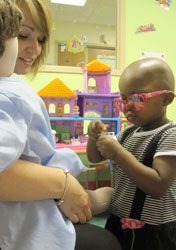Jade Tukan is an inquisitive 2-year-old with bright eyes and a confident smile, but her life was terribly disrupted when she was given a diagnosis of a deadly cancer, acute myeloid leukemia, in January. As her family focused on her medical care, it was sometimes hard to remember that Jade was still wanted to play, even while hooked up to a chemotherapy drip.
That’s where Liz Anderson came in.
Anderson is one of 16 child life specialists at Children’s National Medical Center. “The purpose of my job is to make the hospital as least traumatic and stressful as possible,” she explains.
Anderson, 25, does not provide direct medical care. Instead, she helps Jade remain a kid despite all of the extraordinary things happening to her, often by guiding her in play, which is “the basis of how a child learns and grows,” Anderson says.
Jade’s mother, Taneika Tukan, said she couldn’t imagine how the family would have gotten through Jade’s treatment without the hospital’s child life specialists.
“When we first got the diagnosis, everything stood still,” Tukan says. Doctors gave the little girl just a 50 percent chance of survival. “We were really trying to cherish every moment we had with Jade, but there was a lot of sadness we were experiencing.”
Anderson visited with the family almost daily, bringing toys and books when Jade was in isolation, explaining the medical care to Jade in child-friendly language and even helping her older brother express his feelings about Jade’s illness. “Whenever Jade was going through a particular funk or was a little drained from a treatment, we could ask the nurse to call Liz, and she would show up with something that would cheer her up,” Taneika Tukan recalls.
An Expanding Field
There are more than 4,000 child life specialists across the country. Every pediatric hospital in the country has a child life program, according the Children’s Hospital Association, as do many general hospitals with large pediatrics units.
The specialists must have a college degree, with classes in child development, psychology and similar subjects. They must also complete an internship of at least 12 weeks.
Dennis Reynolds, executive director of the Child Life Council, a Rockville-based professional organization for the specialists, says the number of people seeking certification is outpacing the number of available jobs. But he adds that he expects the field to grow as general hospitals and even dental offices and clinics add child life specialists to their staffs.
Child life specialists usually earn $40,000 to $60,000 a year. Their services are not reimbursed by insurers. Instead, the cost is part of the hospital’s overhead, like electricity or maintenance. Children’s spends about $800,000 a year on its program.
That expense is “greatly worth it,” says Mark Wietecha, president and chief executive of the Children’s Hospital Association. “It’s really almost an insignificant amount of money . . . to let the sickest kids have some opportunity to a life and be re-assimilated,” he adds.
The programs have been so successful that many children’s hospitals are expanding them into outpatient units to help patients undergoing tests and procedures such as MRI scans and tonsillectomies.
Before outpatient surgery, for example, Children’s child life specialists bring kids a coloring book, “Travel Through Surgery With Dr. Bear,” which walks them through the experience. The book includes an autograph page where the children can have all of their doctors and nurses sign, as if they’re characters at Disney World.
While children wait for surgery, the specialists give them anesthesia masks and oils that smell like bubblegum, cotton candy and strawberry to make the masks more pleasant to wear.
Improving Safety
“Even the most old-school and ornery surgeons” are grateful for child life specialists, says Rahul Shah, an ear, nose and throat surgeon at Children’s. “What looks like a warm and fuzzy interaction actually has significant productivity gains for us,” he explains.
Without a child life specialist, he continues, “you’re pulling [patients] sometimes away from the parents. The parents are upset, the child is upset. It heightens their anxiety. When you bring them back to the operating room, it’s a lot harder to put them back to sleep, it’s a lot harder to give them an IV.”
Shah estimates that each visit with a child life specialist can save his surgical team three to five minutes. “With 10 kids, that’s 50 minutes – that’s another surgery,” he explains.
The hospital believes that child life specialists improve not only productivity but also safety. In January, Children’s started a program called “MR-I Can Do It” to reduce the need for anesthesia during MRIs. In rare cases, anesthesia can cause allergic reactions, breathing problems and heart irregularities in children.
Before the program started, almost all children younger than 12 were automatically sedated with anesthesia for the exam, which requires kids to stay still in a confined tunnel for about 60 minutes, often in an uncomfortable position.
But the hospital has found that an hour and a half with a child life specialist can make anesthesia unnecessary. Before the exam, the specialist takes the child into a playroom, and the child is given a cloth doll to put through a mini mock MRI scanner, to help teach them about the procedure. The kids also crawl through tunnels, where the specialists play audio of the loud buzzing sounds of an MRI, so they’ll know what to expect.
During the exam, specialists give the kids cinema-vision goggles through which they can watch movies that look as if they’re playing on a big theater screen and noise-canceling headphones to help distract them. So far, more than 125 kids have had an MRI with no sedation; the youngest was not yet 3.
‘It’s Just Really Awesome’
On a recent day, during Jade’s fifth and final round of chemo, Anderson offered her a life-size cloth doll with a central line tube just like the one protruding from the little girl’s chest. Jade, who wore sparkly pink sunglasses despite being indoors, looked at the doll’s tube, amazed. “Tubie!” she proudly proclaimed, before fetching a plastic syringe from a toy medical kit and injecting her with pretend medication with impressive accuracy.
“She knows and understands details we’d never think she would,” Anderson says. “She recognizes that the tubes have to be cleaned first, that the syringe gets twisted on. Those are things we’d never expect a 2-year-old to understand, let alone process, so we need to make sure she’s understanding the right things.” Manipulating the toys in a play setting allows her to “process what’s happening to her in a non-traumatic way.”
After eight months in and out of Children’s oncology unit, Jade is now back home with her family in Fort Washington. “It’s just really awesome,” her mom says. “We’re still a little tired, but really we’re just overjoyed to be at home and to see her fall into the swing of things, playing with her brother and just doing everything a normal 2-year-old should be doing.”








